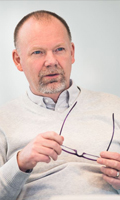
Dr. Anders Ynnerman - Professor in Scientific Visualization, Linköping University
Background
Anders Ynnerman received a PhD in physics from Gothenburg University in 1992 with a dissertation on computational atomic perturbation theory. During his PhD and as a postdoc at Oxford University, UK, and Vanderbilt, USA, he developed simulation codes for massively parallel computing systems and visualization methods for efficient data analysis. In 1997 he was appointed director of the Swedish National Supercomputer Centre (NSC) and in 2002 he founded the Swedish National Infrastructure for Computing, which he directed until 2007.Ynnerman is currently an affiliated faculty member of the SCI institute. He is holding the chair in scientific visualization at Linköping University and he is the founder and director of the Norrköping Visualization Center, a focal point for visualization and graphics research and development in Europe. The center has a public arena with a large-scale dome theater and interactive exhibits, showcasing visualization research and applications.
